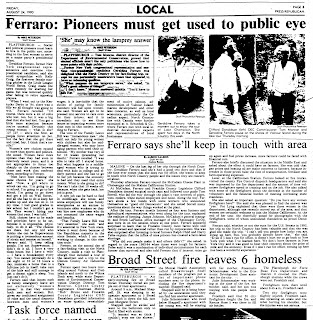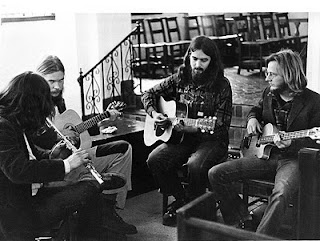Me and Gerry, messin' with the media
The news of Geraldine Ferraro's death should leave a sense of loss for her position as a "first," and, though I don't much care for groundbreaker stories, I certainly talked to her about that one in this story from August, 1990. There are some other things we discussed, too, and I think this was a pretty good story. If you're curious, clicking on the illustration could make it large enough to read; if not, right clicking and saving it to your desktop would give you a legible copy.
But what I remember her for, what makes me chuckle every time, isn't in this article.
Working in Plattsburgh meant working in a competitive media market. It could have been very competitive, given the proximity to a major city, but the international border meant that, rather than being a suburb of Montreal, we were a nearby irrelevance. And, for print purposes, the combination of a state border and Lake Champlain made us of no interest to the Burlington Free Press.
But we did have three radio stations with commitments to local news (two of them commercial, which tells you how long ago this was), and, most of all, there was WPTZ, Channel 5, the NBC affiliate in the Burlington/Plattsburgh market. Although they served both sides of the lake, they were headquartered on the New York side and took their commitment to Plattsburgh seriously.
They were also, I will admit, pretty good at what they did, and one reporter in particular knew the market and went after things with a vengeance. If Carol Monroe was on the story, we'd better be, too, because people would see her reports at 6 and 11 and expect to see something as good, or better, in the Press-Republican the next morning. There were times she had something at 6 that would send us scrambling to keep up, and then there were the times she'd have something only at 11, by which time it was too late for us to make deadline. She'd have us.
The advantage we had was that they had to be visual and we really didn't. So at a news conference, rather than three minutes of talking heads, they would start shooting "reporters watch talking head" video to jazz things up a little, in which they would pan over us as we were writing in our notebooks. And I would write "Hi, Mom!" in my notebook and turn it to the camera to photobomb their shot. It wasn't like we were live, but it would mean a little more time in the editing booth.
In August, 1990, Geraldine Ferraro came to the area and spoke at a gathering in the late morning, then toured a factory or two and headed out on Lake Champlain with some local politicians and some people from the Department of Environmental Conservation. And one reporter, since I had cleared my decks and was dedicating the day to following her around.
There is always a lot of hurry-up-and-wait in these events, as well as transit time, and, when you're the only "Boy on the Bus," you get some substantial facetime. By the time we got into the middle of the afternoon, and into an open boat headed for Crab Island, there were maybe eight of us. I already knew the local pols, and so, by then, we were just a bunch of people going to look around at stuff, and it had become pretty chatty and casual.
As we returned to shore, it was about four in the afternoon, and we'd seen Crab Island and we'd talked about colleges (there was one visible on the hill) and lamprey (I hope you can read the sidebar on that article) and Pat Schroeder's kids (I used to live in Colorado) and now we're coming back to the long dock at the Peru Boat Launch, and, perched on the hill at the top of the long wooden steps, we can see the Channel 5 van, a tripod and a two-person reporter/video team.
They were there to get a few words with Geraldine Ferraro, having missed out on the first six hours of her visit. And I probably made some smartass remark about the necessary establishing shot of Geraldine Ferraro getting out of the boat and then walking up the dock and mounting the steps to the parkinglot. And she must have laughed. I do not remember the exact conversation that took place. Or who contributed what to what followed.
But the result was that Carol's necessary establishing shot turned out to be Geraldine Ferraro stepping out of the open boat onto the dock, then turning around and extending her hand to the reporter from the Press-Republican to help him up onto the dock, and then the two of us walking up that long dock and those long stairs, laughing, talking and all but arm-in-arm.
The only story that the necessary establishing shot could have been used for was "Geraldine Ferraro Comes To The North Country To Hang Out With Her Very Closest Friend, Mike Peterson."
This was not the story Carol had been hoping to file for a newscast that began in less than two hours.
"I'm going to kill you, Peterson," she hissed, as we passed. Her report that evening consisted of shots of her talking to Ferraro in the parking lot, asking a question and getting an answer and moving the handheld mic back and forth.
I still chuckle to myself when I think of it, not so much because of what I did to Carol so much as because I still can't believe a public figure of Geraldine Ferraro's stature would so cheerfully join in pranking the media.
Got a nice note from her a few days later, in which she enclosed Pat Schroeder's Christmas card from the year before, to resolve the issue of how old Schroeder's children were. (She was, of course, right.)
Fun, funny lady. If every day in the newsroom had been like that, I'd still be a reporter.












